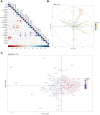Genome-wide association studies in a diverse strawberry collection unveil loci controlling agronomic and fruit quality traits
- PMID: 39406253
- PMCID: PMC11628880
- DOI: 10.1002/tpg2.20509
Genome-wide association studies in a diverse strawberry collection unveil loci controlling agronomic and fruit quality traits
Abstract
Strawberries (Fragaria sp.) are cherished for their organoleptic properties and nutritional value. However, breeding new cultivars involves the simultaneous selection of many agronomic and fruit quality traits, including fruit firmness and extended postharvest life. The strawberry germplasm collection here studied exhibited extensive phenotypic variation in 26 agronomic and fruit quality traits across three consecutive seasons. Phenotypic correlations and principal component analysis revealed relationships among traits and accessions, emphasizing the impact of plant breeding on fruit weight and firmness to the detriment of sugar or vitamin C content. Genetic diversity analysis on 124 accessions using 44,408 markers denoted a population structure divided into six subpopulations still retaining considerable diversity. Genome-wide association studies for the 26 traits unveiled 121 significant marker-trait associations distributed across 95 quantitative trait loci (QTLs). Multiple associations were detected for fruit firmness, a key breeding target, including a prominent locus on chromosome 6A. The candidate gene FaPG1, controlling fruit softening and postharvest shelf life, was identified within this QTL region. Differential expression of FaPG1 confirmed its role as the primary contributor to natural variation in fruit firmness. A kompetitive allele-specific PCR assay based on the single nucleotide polymorphism (SNP) AX-184242253, associated with the 6A QTL, predicts a substantial increase in fruit firmness, validating its utility for marker-assisted selection. In essence, this comprehensive study provides insights into the phenotypic and genetic landscape of the strawberry collection and lays a robust foundation for propelling the development of superior strawberry cultivars through precision breeding.
© 2024 The Author(s). The Plant Genome published by Wiley Periodicals LLC on behalf of Crop Science Society of America.
Conflict of interest statement
The authors declare no conflicts of interest.
Figures








Similar articles
-
Quantitative trait loci and underlying candidate genes controlling agronomical and fruit quality traits in octoploid strawberry (Fragaria × ananassa).Theor Appl Genet. 2011 Sep;123(5):755-78. doi: 10.1007/s00122-011-1624-6. Epub 2011 Jun 11. Theor Appl Genet. 2011. PMID: 21667037
-
A major QTL region associated with powdery mildew resistance in leaves and fruits of the reconstructed garden strawberry.Theor Appl Genet. 2025 Apr 7;138(4):93. doi: 10.1007/s00122-025-04871-6. Theor Appl Genet. 2025. PMID: 40195180 Free PMC article.
-
Exploration of a European-centered strawberry diversity panel provides markers and candidate genes for the control of fruit quality traits.Hortic Res. 2024 May 14;11(7):uhae137. doi: 10.1093/hr/uhae137. eCollection 2024 Jul. Hortic Res. 2024. PMID: 38988619 Free PMC article.
-
Molecular bases of strawberry fruit quality traits: Advances, challenges, and opportunities.Plant Physiol. 2023 Sep 22;193(2):900-914. doi: 10.1093/plphys/kiad376. Plant Physiol. 2023. PMID: 37399254 Review.
-
Breeding strawberry (Fragaria X ananassa Duch) to increase fruit nutritional quality.Biofactors. 2008;34(1):67-72. doi: 10.1002/biof.5520340107. Biofactors. 2008. PMID: 19706973 Review.
Cited by
-
Loss-of-function mutations in the fruit softening gene POLYGALACTURONASE1 doubled fruit firmness in strawberry.Hortic Res. 2024 Nov 19;12(2):uhae315. doi: 10.1093/hr/uhae315. eCollection 2025 Feb. Hortic Res. 2024. PMID: 40371060 Free PMC article.
-
A Dominance Hypothesis Argument for Historical Genetic Gains and the Fixation of Heterosis in Octoploid Strawberry.Genetics. 2024 Oct 10;228(4):iyae159. doi: 10.1093/genetics/iyae159. Online ahead of print. Genetics. 2024. PMID: 39385702 Free PMC article.
References
-
- Antanaviciute, L. , Vickerstaff, R. , Gomez‐Cortecero, A. , Marina‐Montes, C. , Llorente‐Garcia, A. , Battey, N. H. , & Harrison, R. J. (2017). Correlation analysis and QTL mapping of fruit quality and plant architecture traits in cultivated strawberry (Fragaria × ananassa). Acta Horticulturae, 1172, 307–316. 10.17660/ActaHortic.2017.1172.58 - DOI
-
- Atwell, S. , Huang, Y. S. , Vilhjálmsson, B. J. , Willems, G. , Horton, M. , Li, Y. , Meng, D. , Platt, A. , Tarone, A. M. , Hu, T. T. , Jiang, R. , Muliyati, N. W. , Zhang, X. , Amer, M. A. , Baxter, I. , Brachi, B. , Chory, J. , Dean, C. , Debieu, M. , … Nordborg, M. (2010). Genome‐wide association study of 107 phenotypes in Arabidopsis thaliana inbred lines. Nature, 465, 627–631. 10.1038/nature08800 - DOI - PMC - PubMed
-
- Barbey, C. R. , Hogshead, M. H. , Harrison, B. , Schwartz, A. E. , Verma, S. , Oh, Y. , Lee, S. , Folta, K. M. , & Whitaker, V. M. (2021). Genetic analysis of methyl anthranilate, mesifurane, linalool, and other flavor compounds in cultivated strawberry (Fragaria × ananassa) . Frontiers in Plant Science, 12, Article 615749. 10.3389/fpls.2021.615749 - DOI - PMC - PubMed
-
- Bassil, N. V. , Davis, T. M. , Zhang, H. , Ficklin, S. , Mittmann, M. , Webster, T. , Mahoney, L. , Wood, D. , Alperin, E. S. , Rosyara, U. R. , Koehorst‐vanc Putten, H. , Monfort, A. , Sargent, D. J. , Amaya, I. , Denoyes, B. , Bianco, L. , van Dijk, T. , Pirani, A. , Iezzoni, A. , … van de Weg, E. (2015). Development and preliminary evaluation of a 90 K Axiom® SNP array for the allo‐octoploid cultivated strawberry Fragaria × ananassa . BMC Genomics, 16(155), Article 155. 10.1186/s12864-015-1310-1 - DOI - PMC - PubMed
MeSH terms
Grants and funding
- P18-RT-4856/Consejería de Economía, Innovación, Ciencia y Empleo, Junta de Andalucía
- BreedingValue 101000747/Horizon 2020 Framework Programme
- PID2022-138290OR-I00/AEI/10.13039/501100011033/Ministerio de Ciencia e Innovación y Agencia Estatal de Investigación
- PID2019-111496RR-I00/AEI/10.13039/501100011033/FEDER, UE Ministerio de Ciencia e Innovación y Agencia Estatal de Investigación
LinkOut - more resources
Full Text Sources

